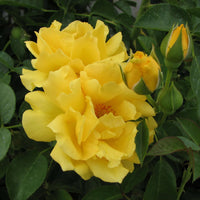Julia Child Rose is a beautiful, low-maintenance floribunda rose known for its butter-yellow blooms and delightful licorice fragrance. Here’s how to properly plant and care for this popular rose variety:
Planting Guide:
Location:
- Choose a spot with full sun, where the plant can receive at least 6 hours of direct sunlight each day. More sun typically leads to better blooms.
- Ensure good air circulation around the plant to help prevent fungal diseases.
Soil:
- Prefers well-drained, fertile soil. Amend the planting area with compost or well-rotted manure if the soil is heavy or poor.
- The soil should be slightly acidic to neutral (pH 6.0 to 6.5). If the soil is too alkaline, consider adding soil acidifiers to adjust the pH.
Planting Steps:
- Dig a hole that is twice as wide and just as deep as the root ball.
- Place the rose bush in the hole, making sure the graft union (the swollen part where the rose was grafted onto rootstock) is about 1-2 inches below the soil surface in cooler climates or slightly above ground level in warmer climates.
- Backfill the hole with soil, gently pressing it down to eliminate air pockets.
- Water thoroughly after planting to help the soil settle around the roots.
- Apply a 2-3 inch layer of mulch around the base, keeping it a few inches away from the stems to retain moisture and reduce weeds.
Care Guide:
Watering:
- Water deeply and consistently, especially during the first growing season to help establish a strong root system. Roses need about 1-2 inches of water per week, either from rain or irrigation.
- Water at the base of the plant to avoid wetting the foliage, which can lead to fungal diseases. Early morning is the best time to water.
Fertilizing:
- Feed with a balanced, slow-release rose fertilizer in early spring, just as new growth begins.
- Repeat feeding every 6-8 weeks throughout the growing season (spring through early fall) to encourage continuous blooming.
Pruning:
- Prune in late winter or early spring before new growth starts. Remove any dead, damaged, or crossing branches to improve air circulation and shape the plant.
- Cut back the stems by about one-third to half their length to encourage vigorous growth and more blooms.
- During the growing season, deadhead spent blooms to promote continuous flowering.
Pest and Disease Management:
- Julia Child Roses are generally disease-resistant, but it’s still important to check for common rose problems such as black spot, powdery mildew, and aphids.
- Regularly inspect the plant and treat pests with insecticidal soap or horticultural oils if necessary.
- Prevent fungal diseases by ensuring good air circulation and avoiding overhead watering.
Mulching:
- Apply a 2-3 inch layer of mulch around the base of the plant. Mulch helps retain moisture, suppress weeds, and regulate soil temperature.
- Refresh the mulch as needed, but keep it away from the base of the plant to avoid rot.























